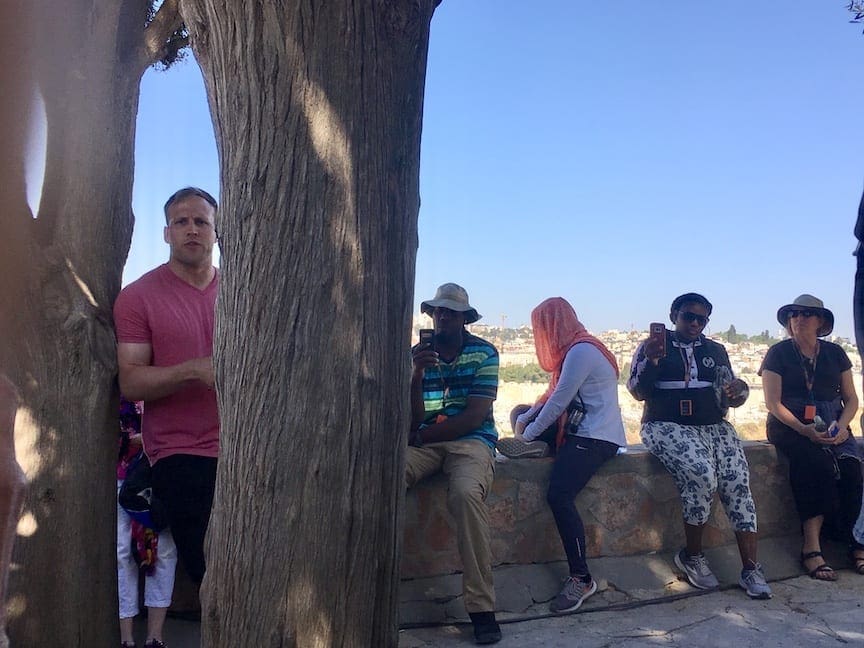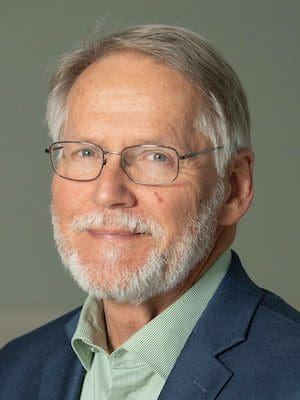
From the Mount of Olives, one has a stunning view of the Old City of Jerusalem while overlooking a large Jewish cemetery.
Some folks might wonder why I keep posting blogs cataloging each tour group I take to Israel, the West Bank, and occasionally Jordan: I’ve done it (you can look them up!) in 2009, 2011, 2013, 2014, 2015, 2017, and this year — not to mention other travels for Campbell University Divinity School and Nurturing Faith Experiences.

Rudi Rudisill leads a devotional time at Dominus Flevit, which commemorates Jesus weeping over Jerusalem.
The main reason I do is so that friends, family, and other interested folk can follow people they care about on the trip, see an occasional picture of them, and share the experience vicariously. Another reason is that the trip is so rich and full of new things that it can be hard to keep everything straight: Where did we go on Monday? Where did I take this picture? We often diverge from the printed itinerary, so it’s not always helpful. With access to the blogs, however, folks who went on the trip can review what we did each day, helping them to organize their pictures and thoughts more easily.
Here’s a quick roundup of our last two days: on Monday May 20 we began on the Mount of Olives and walked down the Palm Sunday Road. Along the way we stopped to look over a massive Jewish cemetery, paused for a devotion at Dominus Flevit, and visited the Garden of Gethsemane, where the Church of All Nations holds out hope for world peace.
As the road reached the Kidron Valley, we boarded our bus for the Herodion (also called the Herodium), a palace-fortress that Herod the Great built outside Jerusalem after he killed his Jewish wife Mariamne, and said he could no longer stay in his Jerusalem palace because of the memories. Herod still wanted to see Jerusalem, so he had builders bring in enough soil to double the height of a small mountain before building his palace-fortress on top, with lavish gardens and pools below.

Jack Sara, president of Bethlehem Bible College, greets group members after we delivered several boxes of school supplies, children’s vitamins, and other donated items for the school and its ministries.
The Herodion is just a few miles from Bethlehem, where we visited Bethlehem Bible College for a lunch of maqlooba (chicken and cauliflower with rice and special spices), to shop in their gift shop, and to hear a lecture from Bishara Awad, the founder of the college. This is the only opportunity many people get to talk directly with Palestinian Christians and hear from them what it is like to live under Israeli occupation. We are always amazed at how gently they discuss the subject, showing awareness of the difficulties involved in seeking a solution acceptable to both parties.
We also visited the Church of the Nativity, where renovations that have been going on for years are finally producing visible results: marble columns have been cleaned, revealing paintings beneath the soot, and beautiful mosaics from an earlier floor of the church (well beneath the present floor) have been cleaned and moved to a space high on the walls of the sanctuary.
That visit included a climb down into a cave where the fourth-century cleric Jerome reportedly lived while translating the Bible from Hebrew and Greek into excellent Latin. His work, known as the Vulgate, became the standard text of the church for more than 1,000 years before the advent of the Protestant Reformation and the translation of the Bible into other languages.

A monument to Jewish soldiers who died in World War II. The memorial was designed and built by Bernie Fink, an artist Susan and I got to know at his home in Kibbutz Yizre’el (Jezreel).
On Tuesday, our final day, started later than usual and went first to the Yad VeShem, Israel’s holocaust museum. We visited the Children’s Memorial together (no pictures allowed), then had freedom to visit other museums or sites on the property.
After a delightful hamburger lunch at the “Elvis American Diner” in Kiriath-Jearim (where the Ark of the Covenant was once held in quarantine for 20 years), we went to the Garden Tomb. There we saw how the face of the cliff that once looked skull-like has deteriorated so that it’s now hard to make out where it was. Each person had a chance to climb inside a hillside rock-cut tomb that is reminiscent of the tomb where Jesus was buried. Donna Burgan led us in a devotion before we shared communion.
A visit to the Israel Museum is always a necessity and never long enough. There we saw an impressive 1/50 scale model of first century Jerusalem before adjourning to a special area where samples of the Dead Sea scrolls are displayed, along with the 1000-year-old Aleppo Codex, the 13th century Small Codex, and other important texts.

A reconstructed sandstone altar from Beersheba, which was used in the eighth century and possibly destroyed as a Hezekiah’s reform efforts.
Inside the main museum, we saw treasures beyond measure from excavations in Israel, wishing we had more time to see more and soak it all in.

Dinner was held at a restaurant whose Hebrew name – Hazaken Hayom — translates to “The Old Man and the Sea”
Our last activity before heading to the airport was a nice farewell dinner by the sea in Joppa, the port city made famous by the story of Jonah, and from which Paul also took ship. Joppa is now called Yafo, and is considered part of Tel Aviv-Yafo. The sunset was beautiful and the food was good, but neither matched the good fellowship of being with new friends and old, enjoying the special experience of visiting the land where so many stories of faith were played out.
If you’d like to share experiences like these in person, you’re in luck: next May 20-29 I’ll be taking a group through Nurturing Faith Experiences, and we’ve set the schedule so that participants only have to miss one Sunday. Don’t you think your pastor and his or her spouse would benefit from joining us? For more information, contact me at [email protected] or watch for updates in the fall issues of Nurturing Faith Journal and Bible Studies.
(Thanks to Susan for several of these photos)








